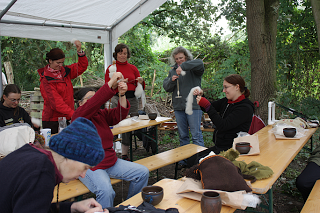I'm back home again, up and running - and blogging (even if it's slightly later than usual due to a much-needed battle against sleep deficiencies). So what have I been up to in these last two weeks?
First, there was Tannenberg. The traditional season's end market and, like Freienfels, usually resembling something like a fair to see different craftspeople and sellers of medieval tools and paraphernalia. This year, however, Tannenberg was rather subdued in atmosphere and with much less participants than the years before. We all wondered why - maybe all the fear-mongering about bad times and recession, combined with real-life struggling of craftspeople and participants, have finally had their impact on the modern middle ages as well. Still, we had a very nice time in Tannenberg, with quite good weather - only one day of rain and drizzle, and not much muddyness at all - and met and chatted with many of our friends and colleagues.
After return on Monday, it was unpacking, drying, sorting out of things and then, for me, preparing for Hungary straight away. Since I had to finish the presentation too, Tuesday was quite short for that - but everything got packed up in time, clothes stuffed into a bag, the trusty laptop bundled up, and off I went to a wonderful and truly memorable conference in
Százhalombatta, a town some thirty km from Budapest. The conference was both the
EXARC meeting and the last meeting of
liveARCH, a project connecting eight archaeological open air museums from eight different countries. It was wonderfully organised by the
Matrica Museum and archaeological park of Százhalombatta, including lodgings and transfer from and to the airport (what luxury not to book anything beyond the flight). It was everything I wish for in a conference: lots of people with different experiences and points of view meeting for good, interesting and sometimes thought-provoking presentations, many academic discussions, common meals, excursions to both stretch the legs and see something else for a while (including something typical for the country and/or region), enough coffee breaks with sweets (yes, the local sweets are actually something I enjoy maybe too much on a conference) and more long, varied discussions. Because everything except, of course, the excursions, took place at the hotel and meals were also organised by the conference team, everyone was kept closely together, and there was no scattering to different watering holes for meals and during free time. And that is another thing that makes a successful conference, to me: Keeping everyone together so that networking, chatting, joking and discussing is made easy, because all the others are quite within reach.
And because during liveARCH it became very clear to everybody that there is one single key to good cooperation and to success with networking, perfectly summarised during one of the lectures as "communication, communication, communication", every evening the "liveARCH Social Club" was opened for having a drink and a chat or five between friends. And every evening I got to bed later and later... explaining the sleep deficiencies and, thus, the lateness of today's blog post.




